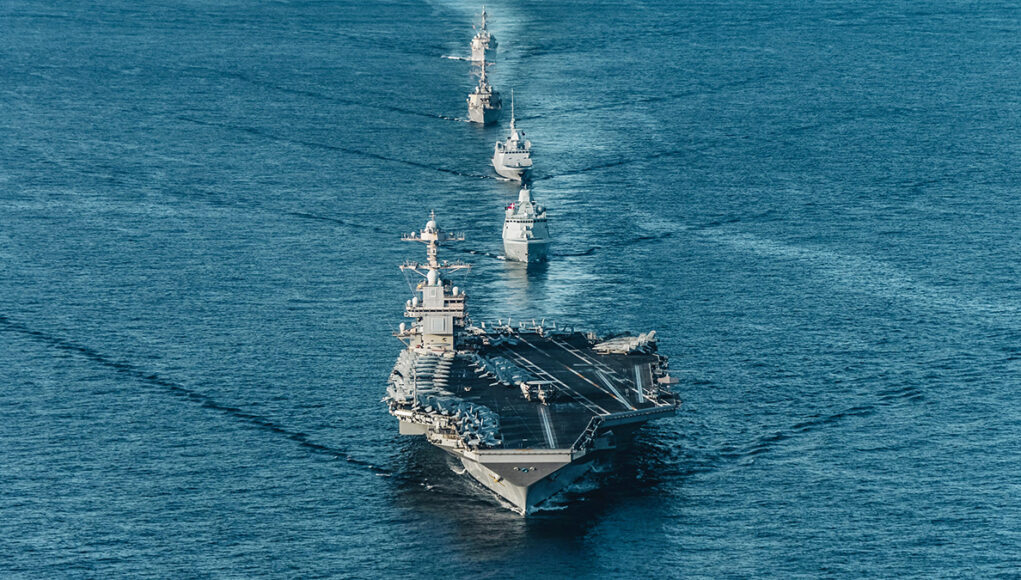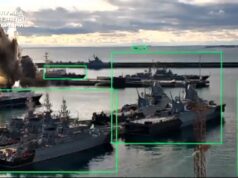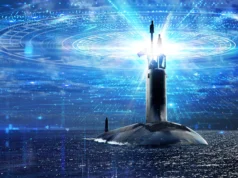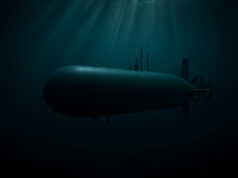The world’s largest aircraft carrier, USS Gerald R. Ford (CVN 78), is spearheading NATO’s latest Neptune Strike exercise, sailing in formation with allied warships in the North Sea as part of a major demonstration of maritime power directed at deterring Russian aggression.
Running from 22 to 26 September, Neptune Strike 25-3 brings together more than 10,000 sailors, soldiers, aviators and marines from 13 allied nations. The exercise spans the Mediterranean, Adriatic, North and Baltic Seas and is designed to test NATO’s ability to integrate high-end maritime strike capabilities while securing critical waterways and chokepoints.
A U.S. Navy photograph released from the exercise shows Gerald R. Ford leading the Danish frigate Niels Juel, the French frigate FS Bretagne, and the U.S. destroyers USS Mahan and USS Winston S. Churchill in tight formation.
Led by Naval Striking and Support Forces NATO (STRIKFORNATO), headquartered in Oeiras, Portugal, Neptune Strike 25-3 places NATO in operational control of a carrier strike group alongside amphibious and submarine forces. Among the assets involved are Turkey’s amphibious assault ship TCG Anadolu, Italy’s landing ship ITS San Giorgio, and the U.S. command ship USS Mount Whitney.
Operations include carrier-based sorties, amphibious landings in southern Italy, submarine patrols, surface warfare, and a mass casualty drill.
In the North Sea, the Gerald R. Ford Carrier Strike Group is acting as the centrepiece of NATO’s deterrent posture, while multinational task groups operate simultaneously in the Baltic and Mediterranean.
The Neptune Strike series, first conceived under NATO’s Project Neptune in 2020, underscores the Alliance’s ability to rapidly integrate multinational naval and strike forces. NATO stresses the activities are defensive in nature and conducted in full compliance with international law. This latest iteration comes amid rising tension over repeated Russian air and drone incursions into allied airspace.














Ha, I see she has regained her title of “Worlds most powerful Warship” again, this title was missing from the previous Article, just the “Worlds largest Warship” in that article.
Largest = Most Powerful.
Or does it ?
I’m American and even I admit that USS Gerald R. Ford isn’t even our most powerful aircraft carrier at the moment (not till it gets an F-35 squadron assigned).
Anyway, SSBNs are the most powerful warships.
I think “Worlds largest warship” is a better title.
SSBNs are boats. In any case- being pedantic- flat tops aren’t at all powerful. Strike aircraft are powerful, and the carriers are enablers for them. Technically, the most powerful ‘major surface combatant’ is probably the Russian Admiral Nakhimov, although I don’t think she’d survive 5 minutes against a US Carrier Group.
Or a Ukrainian Drone “boat”.
So maybe said drone boat is the most powerful ?
Firstly, please accept my deepest sympathies, we can’t help where we are born ! 😁😁😁 and according to World experts, the F35 can’t even fire off any missiles (I read it here).
Obviously I’m only mildly taking the Piss, most of my remaining family now reside in your great country.
Largest is the better label, I agree.
halfwit, You are the best commenter on this site by far. An American posting on a UK website has to expect to take some grief occasionally:)
Nevertheless many on here appreciate the view from ‘over there’, and indeed from folk from other countries. I know I do.
Cheers CR
Hey CR, exactly my view too. There are always at least two sides to any story and a whole Ship/Boat load of different views, I like to gather as much info from all sides before deciding where to pitch my sarcastic nonsense.
😁
Paul, thank you, you are too kind (odd, deluded, mad, or something else !!!!) I feel deeply honored to be given such an accolade.
Are there any Medals at all ?
🥇🎖️🏅🏆
Get a room you two.
😁
Halfwit taking the Starmer approach to international diplomacy!
Can my day get any better?
Oh bugger, I didn’t realise I was that bad !
10.30pm is probably too late for anything better to happen, maybe you’ll have more luck in the morning !
How come you have a picture, It’s not fair, I want a picture ?
Not quite that bad, at least you didn’t offer HIM medals!
The picture is because I use a site called Gravatar, which inputs the same photo onto all of the comments sites. I’m not sure why there isn’t a function for that within UKDJ.
Are we going to see a Motorbike pfp in the next few days?
I’ll take a look, might be difficult to choose a Bike pic, most Gif and other sites are American and very America specific so a bloody Harley might be the only option.
Harleys are Shite, ancient cast Iron Farm Vehicles that Fat blokes love to make noise on.
I have a nice collection of iconic Japanese and Italian bikes, not sure which I’d choose for a PFP.
Davidson family had Scottish roots’.
Oh you don’t need an online image, you can upload one of your own- so you can have as arty a pic of your own bikes as you want!
Might just do that. Would a face shot help too ?
1975 Ducati 900SS
Fen Tiger, Yes and that’s what Harleys are good at, ripping out stubborn Roots.
A cringing, grovelling, bowing, scraping, fawning, sycophantic, obsequious, toadying lickspittle sucking up to a fried chicken eating, Vietnam war losing, 9/11 snivelling, Afghanistan surrendering, TRUMP MONKEY. Not exactly unheard of these days, unfortunately.
I’m old enough to remember a time when folk in this country had pride, self respect, honour and dignity. Sadly, all gone now. R.I.P. my England, R.I.P.
😞🏴🪦
When Russia and China, Iran and even husitie from Yemen
have Hypersonic missiles this big ship is just another big target. Nobody from NATO , including USA, don’t have it.
The message sent to the Russians was look at how big a target we are, come and have a go if you think you’re hard enough. And then launched lots of P8 poseidon aircraft and numerous surface vessels looking for a Russian sub that had come close enough to launch torpedoes at her. A sub they couldn’t track and never found. That should send alarm bells to the US Navy and Nato. If any of it is true of course.